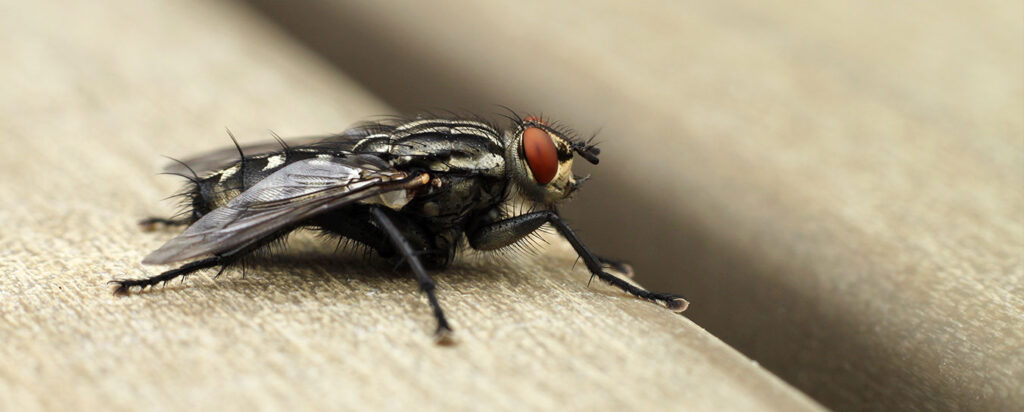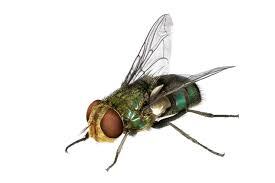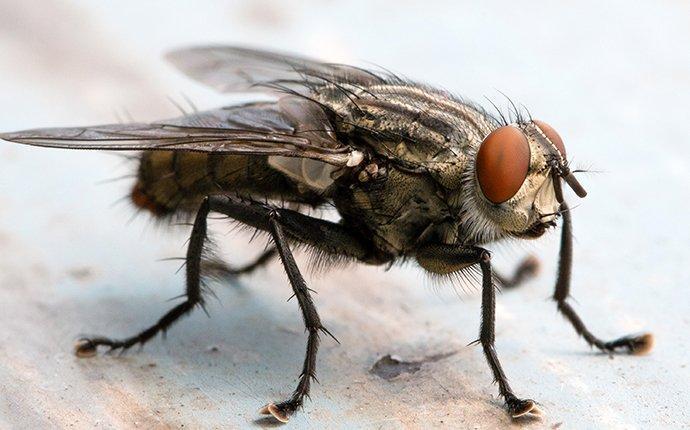Flies

Ask About Our
100% Eco-Friendly
Options
Fly Control Services In Central Wisconsin

Effective Fly Control Strategies: Tackling Infestations and Preventing Disease Transmission
Getting rid of house flies usually requires a mix of indoor and outdoor treatment measures. This is especially true if you have pets that defecate in the yard, compost piles, small bodies of water close by, live near a farm or have unclean trash bins or dumpsters nearby. While eliminating all house flies on your property is not realistic, you can control the fly population to a manageable level.
Fly infestations in Central Wisconsin can range from a minor nuisance to a major problem. Flies reproduce exceedingly fast with one pair of flies resulting in over a million new flies in a matter of weeks through their own mating and that of their offspring. Prevention is truly the key when it comes to fly infestations, and knowing the source of the flies is imperative to the success of eradication. The expert team at 1st Choice Pest Control will help you locate the source of the flies, identify the species, and appropriately treat both the pest and source to remove them and prevent their return. Our comprehensive fly control services will help avoid the numerous problems associated with fly infestations including the transmission of more than 65 diseases such as:
- Cholera
- E. Coli
- Salmonella
Frequently Asked Questions
Signs of a fly infestation may include seeing large numbers of flies in or around your home, finding fly larvae or pupae in food or garbage, and experiencing a foul odor.
Flies can enter your home through open windows or doors, as well as on items such as garbage or pet waste.
Effective fly treatments may include using insecticide sprays or baits, as well as removing any sources of food or garbage. It’s best to consult with a pest control professional for the most effective treatment plan.
To prevent flies from entering your home, keep food and garbage in sealed containers, keep doors and windows closed, and eliminate sources of standing water.
Types of Flies

House Fly
House flies are usually gray in appearance and display four black stripes on their thorax. Adult house flies are about 1/8-1/4” (4 to 7.5 mm) long. They have slightly hairy bodies, a single pair of wings, and compound red eyes, which contain thousands of individual lenses that allow them to have wider vision. Female house flies are usually larger than males. House flies do not have teeth or a stinger. House fly eggs resemble small grains of rice. The eggs hatch into larvae, also known as maggots, which range in size from about ¼-3/8” (7-10 mm) long. Maggots are cream-colored with a greasy appearance. When entering the pupal stage, maggots develop dark, hard outer shells, legs, and wings, ultimately emerging as full-grown adult flies.

Fruit Fly
Fruit flies are attracted to and eat rotting food. They especially like fruits and vegetables as well as fermenting liquids like beer, liquor, and wine. Fruit flies are also attracted to and sometimes breed in dark, moist, and unsanitary environments like drains, garbage disposals, and trash bins where rotting produce materials may collect. Because they reproduce very quickly, fruit fly extermination can be difficult. Female fruit flies can lay around 500 eggs, which can hatch in as little as 24 hours. Similar to other fly species, fruit flies have a four-stage life cycle, which can be completed in as little as a week in ideal conditions.

Drain Fly
Drain flies are often associated with drains and are common at sewage treatment facilities. They are weak fliers and often appear to be jumping or hopping. Flight and mating activities normally occur in the evening hours when they are attracted to lights. Each female can produce around 100 eggs and under optimum conditions, development can be completed in about 2 weeks. Drain flies may be found around bathrooms or kitchen sinks. They are common around wet areas and can even breed in sink and bathroom drain traps, in spite of the hot water, soap, and other debris that flow through them.

Blow Fly
Blow flies are slightly larger than true house flies, and the bodies of many are metallic blue or green. Blow and Bottle flies are found worldwide, occurring in almost every place occupied by people. The name blowfly comes from the rotting animal carcasses' bloated condition that their larvae, known as maggots, infest. Blow flies are one of the most common flies found around dead animals.



 Service Request
Service Request